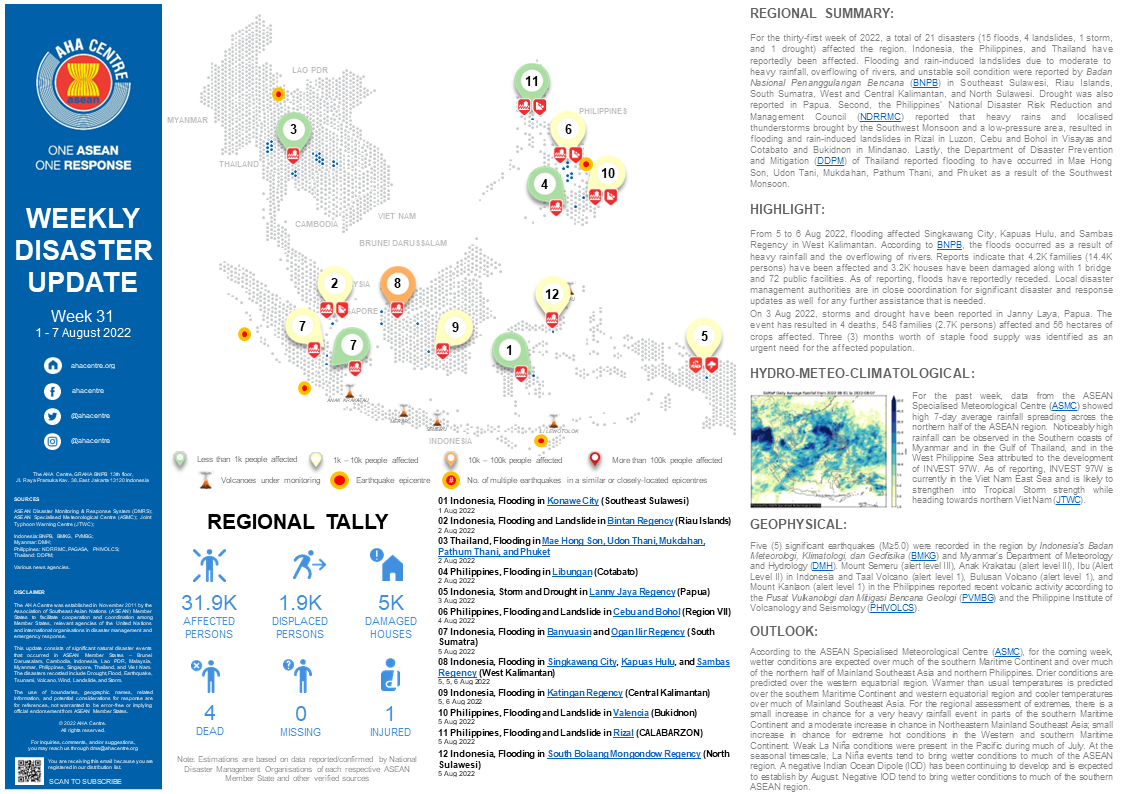
REGIONAL SUMMARY:
For the thirty-first week of 2022, a total of 21 disasters (15 floods, 4 landslides, 1 storm, and 1 drought) affected the region. Indonesia, the Philippines, and Thailand have reportedly been affected. Flooding and rain-induced landslides due to moderate to heavy rainfall, overflowing of rivers, and unstable soil condition were reported by Badan Nasional Penanggulangan Bencana (BNPB) in Southeast Sulawesi, Riau Islands, South Sumatra, West and Central Kalimantan, and North Sulawesi. Drought was also reported in Papua. Second, the Philippines’ National Disaster Risk Reduction and Management Council (NDRRMC) reported that heavy rains and localised thunderstorms brought by the Southwest Monsoon and a low-pressure area, resulted in flooding and rain-induced landslides in Rizal in Luzon, Cebu and Bohol in Visayas and Cotabato and Bukidnon in Mindanao. Lastly, the Department of Disaster Prevention and Mitigation (DDPM) of Thailand reported flooding to have occurred in Mae Hong Son, Udon Tani, Mukdahan, Pathum Thani, and Phuket as a result of the Southwest Monsoon.
.
HIGHLIGHT:
From 5 to 6 Aug 2022, flooding affected Singkawang City, Kapuas Hulu, and Sambas Regency in West Kalimantan. According to BNPB, the floods occurred as a result of heavy rainfall and the overflowing of rivers. Reports indicate that 4.2K families (14.4K persons) have been affected and 3.2K houses have been damaged along with 1 bridge and 72 public facilities. As of reporting, floods have reportedly receded. Local disaster management authorities are in close coordination for significant disaster and response updates as well for any further assistance that is needed.
On 3 Aug 2022, storms and drought have been reported in Janny Laya, Papua. The event has resulted in 4 deaths, 548 families (2.7K persons) affected and 56 hectares of crops affected. Three (3) months worth of staple food supply was identified as an urgent need for the affected population.
HYDRO-METEO-CLIMATOLOGICAL:
For the past week, data from the ASEAN Specialised Meteorological Centre (ASMC) showed high 7-day average rainfall spreading across the northern half of the ASEAN region. Noticeably high rainfall can be observed in the Southern coasts of Myanmar and in the Gulf of Thailand, and in the West Philippine Sea attributed to the development of INVEST 97W. As of reporting, INVEST 97W is currently in the Viet Nam East Sea and is likely to strengthen into Tropical Storm strength while heading towards northern Viet Nam (JTWC).
GEOPHYSICAL:
Five (5) significant earthquakes (M?5.0) were recorded in the region by Indonesia’s Badan Meteorologi, Klimatologi, dan Geofisika (BMKG) and Myanmar’s Department of Meteorology and Hydrology (DMH). Mount Semeru (alert level III), Anak Krakatau (alert level III), Ibu (Alert Level II) in Indonesia and Taal Volcano (alert level 1), Bulusan Volcano (alert level 1), and Mount Kanlaon (alert level 1) in the Philippines reported recent volcanic activity according to the Pusat Vulkanologi dan Mitigasi Bencana Geologi (PVMBG) and the Philippine Institute of Volcanology and Seismology (PHIVOLCS).
OUTLOOK:
According to the ASEAN Specialised Meteorological Centre (ASMC), for the coming week, wetter conditions are expected over much of the southern Maritime Continent and over much of the northern half of Mainland Southeast Asia and northern Philippines. Drier conditions are predicted over the western equatorial region. Warmer than usual temperatures is predicted over the southern Maritime Continent and western equatorial region and cooler temperatures over much of Mainland Southeast Asia. For the regional assessment of extremes, there is a small increase in chance for a very heavy rainfall event in parts of the southern Maritime Continent and a moderate increase in chance in Northeastern Mainland Southeast Asia; small increase in chance for extreme hot conditions in the Western and southern Maritime Continent. Weak La Niña conditions were present in the Pacific during much of July. At the seasonal timescale, La Niña events tend to bring wetter conditions to much of the ASEAN region. A negative Indian Ocean Dipole (IOD) has been continuing to develop and is expected to establish by August. Negative IOD tend to bring wetter conditions to much of the southern ASEAN region.
Sources:
ASEAN Disaster Monitoring & Response System (DMRS); ASEAN Specialised Meteorological Centre (ASMC); Joint Typhoon Warning Centre (JTWC);
Indonesia: BNPB, BMKG, PVMBG;
Myanmar: DMH;
Philippines: NDRRMC, PAGASA, PHIVOLCS;
Thailand: DDPM;
Various news agencies.







